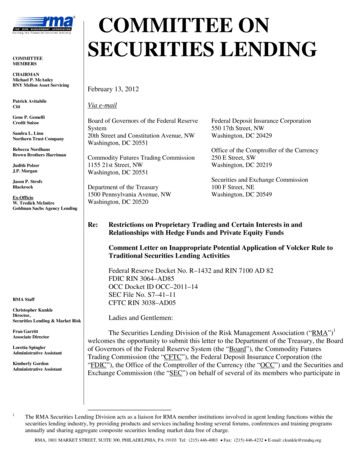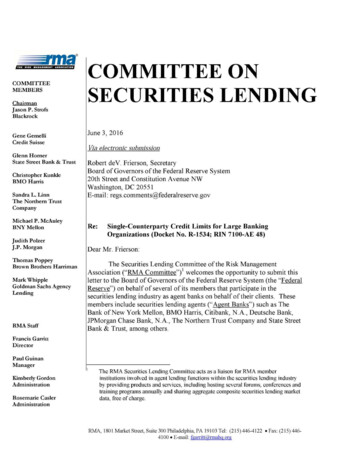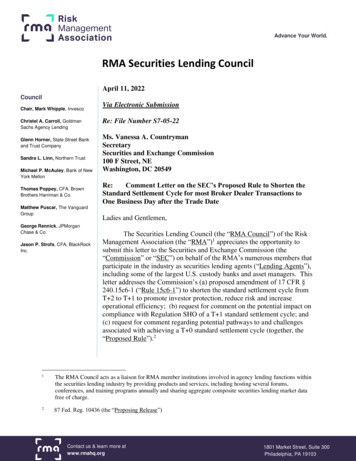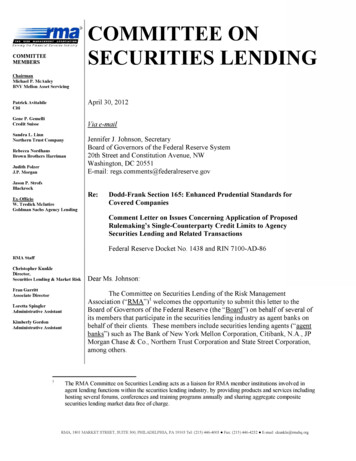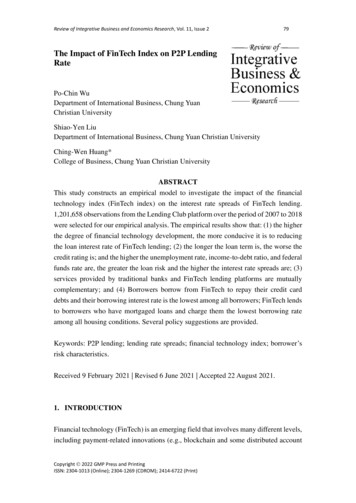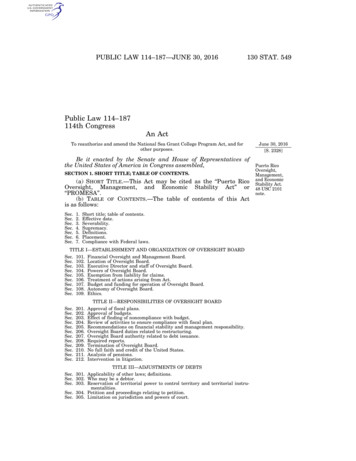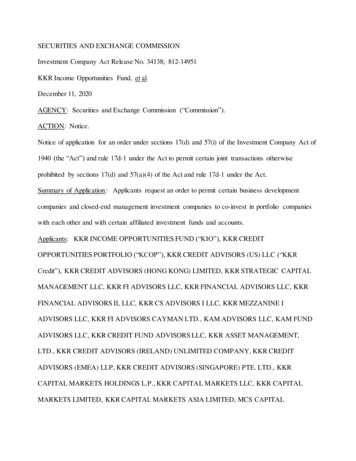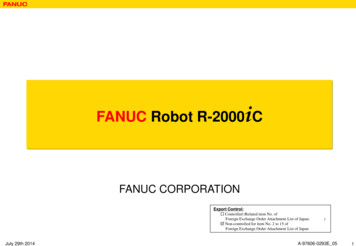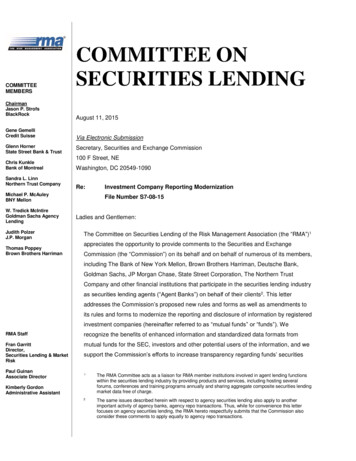
Transcription
COMMITTEEMEMBERSChairmanJason P. StrofsBlackRockGene GemelliCredit SuisseGlenn HornerState Street Bank & TrustChris KunkleBank of MontrealSandra L. LinnNorthern Trust CompanyCOMMITTEE ONSECURITIES LENDINGAugust 11, 2015Via Electronic SubmissionSecretary, Securities and Exchange Commission100 F Street, NEWashington, DC 20549-1090Re:Michael P. McAuleyBNY MellonW. Tredick McIntireGoldman Sachs AgencyLendingJudith PolzerJ.P. MorganThomas PoppeyBrown Brothers HarrimanInvestment Company Reporting ModernizationFile Number S7-08-15Ladies and Gentlemen:The Committee on Securities Lending of the Risk Management Association (the “RMA”)1appreciates the opportunity to provide comments to the Securities and ExchangeCommission (the “Commission”) on its behalf and on behalf of numerous of its members,including The Bank of New York Mellon, Brown Brothers Harriman, Deutsche Bank,Goldman Sachs, JP Morgan Chase, State Street Corporation, The Northern TrustCompany and other financial institutions that participate in the securities lending industryas securities lending agents (“Agent Banks”) on behalf of their clients2. This letteraddresses the Commission’s proposed new rules and forms as well as amendments toits rules and forms to modernize the reporting and disclosure of information by registeredinvestment companies (hereinafter referred to as “mutual funds” or “funds”). WeRMA Staffrecognize the benefits of enhanced information and standardized data formats fromFran GarrittDirector,Securities Lending & MarketRiskmutual funds for the SEC, investors and other potential users of the information, and wePaul GuinanAssociate Directorsupport the Commission’s efforts to increase transparency regarding funds’ securities1The RMA Committee acts as a liaison for RMA member institutions involved in agent lending functionswithin the securities lending industry by providing products and services, including hosting severalforums, conferences and training programs annually and sharing aggregate composite securities lendingmarket data free of charge.2The same issues described herein with respect to agency securities lending also apply to anotherimportant activity of agency banks, agency repo transactions. Thus, while for convenience this letterfocuses on agency securities lending, the RMA hereto respectfully submits that the Commission alsoconsider these comments to apply equally to agency repo transactions.Kimberly GordonAdministrative Assistant
August 11, 2015Page 2 of 9lending activities to facilitate better evaluation of securities lending agent performance and feearrangements. We ask that the Commission consider phasing in the public disclosure of select data toafford both the Commission and the asset management industry time to evaluate potential unintendedconsequences.Our comments are organized into four parts, addressing specific questions related to securities lending asposed for 1) the new Form N-PORT, 2) amendments to Regulation S-X, 3) the new form N-CEN and 4)Form ADV. For convenience, the Commissions questions are restated below in blue.Form N-PORT Form N-PORT would require funds to disclose the aggregate value of all securities on loan to eachsecurities lending counterparty and the name and LEI (if any) of the counterparty. Should we insteadrequire funds to report this information on a loan-by-loan or security-by-security basis? To whatextent, if any, would such information be used by investors and other potential users? What, if any,additional issues would funds face in tracking and reporting such information on a loan-by-loan orsecurity-by-security basis? Do funds currently track or have the ability to readily determine theircounterparty exposure on a loan-by-loan or security-by-security basis? If securities lendingcounterparty information should be reported on a loan-by-loan or security-by-security basis, is thereany additional or alternative information we should require funds to report, such as the rebate orcompensation to the securities lending agent?We concur that disclosure of securities loan information at the counterparty level, as opposed to atthe loan or cusip level, is appropriate. However, we believe counterparty-level information should belimited to the top five or ten counterparties with the greatest exposure. Either would provide theCommission and investors with the information necessary to understand the material exposure that afund has to securities lending counterparties, without imposing unnecessary costs on funds and theirshareholders. Limitation of reporting to the top ten counterparties by exposure would to be consistentwith the N-CEN filing requirement to report exposure to brokers through trading commissions andprincipal trades. More detailed reporting, while generally available to each fund from its agent lender,would exponentially increase the amount of data sent and would not be expected to materiallychange the Commission’s or investors’ risk assessment of the reporting funds.Legal Entity Identifiers (“LEIs”).The financial industry is beginning to adopt LEIs, but many corporate entities have not yet registered.Further, systems are not yet widely in place to track counterparty LEIs. We support providing thenames of securities lending counterparties, and as and when possible agent lenders will report LEIsof both borrowers and lending funds to facilitate downstream regulatory reporting. Accordingly, we
August 11, 2015Page 3 of 9respectfully request that disclosure of counterparty LEIs be either delayed until fully integrated intothe global financial system or, alternatively, as available to the agent lenders and reporting funds.Disclosing to the public, for each securities lending counterparty, the full name and LEI, and theaggregate value of all securities on loan to the counterparty may have unintended consequences onsecurities lending markets. Borrowers may be concerned about details of their exposures being madepublic to clients and competitors, and that concern may make borrowers less likely to borrow fromregistered funds and more likely to borrow from lenders who are not required to make similardisclosures. Therefore, this is one example for which we think phasing in the public disclosure of datamay be prudent. Instead of requiring funds to report the aggregate value of all securities on loan to each securitieslending counterparty, should we limit such disclosures to counterparties to which the fund has thegreatest exposure, such as the top five or top ten counterparties? Alternately, should we requirefunds to report aggregate exposure to a given counterparty only if such exposure constitutes morethan a certain percentage of the NAV of the fund (e.g., one percent)? Would either approach moreappropriately consider the costs of tracking and reporting such information and the benefits thatincreased transparency would provide to the Commission and other potential users?As stated previously, we believe counterparty-level information should be limited to the top five or tencounterparties with the greatest exposure for each fund. Alternately, or in addition, should the Commission request information regarding other types ofcounterparty exposures? For example, should the Commission require funds to report counterpartyexposures based on the amount of unsettled trades with each counterparty? If so, should suchinformation be reported in terms of aggregate or net exposure, and why?Unsettled securities lending trades generally do not create exposure for lending funds. Thisinformation is not typically reported to lenders and we do not believe it to be a meaningful measure ofmarket risk. Should the Commission require funds to report information about securities on loan or reinvestmentof cash collateral at the portfolio level, rather than at the individual security level? If so, whatcategories should be used to report such reinvestment? For example, would it be appropriate to usethe same collateral categories for securities lending that we are proposing to be used for repurchaseand reverse repurchase agreements?Securities on Loan. As the Commission states, many funds today voluntarily identify securities thatare on loan in their schedules of portfolio investments prepared pursuant to Regulation S-X. Funds
August 11, 2015Page 4 of 9have ready access to data regarding individual securities on loan from their securities lending agentsand/or custodians and we believe that filing of such information in XML format will facilitate theCommission’s ability to efficiently analyze it on a regular basis.Cash Collateral Reinvestment. We support the requirement to identify securities, including cashcollateral funds and/or other pooled investment vehicle, that represent the reinvestment of cashcollateral and the disclosure of the dollar value of such reinvestment. As discussed, Form N-PORT would require funds to indicate, for each investment, whether anyportion of the investment represented non-cash collateral received to secure loaned securities. Towhat extent would this information be helpful to brokers, dealers, and investors? To what extent dofunds receive collateral other than cash?Mutual funds are generally limited, by way of historical No-action letters, to accepting only cash andgovernment securities as collateral for their loans of securities and, per industry standard, beneficialowners lending via an agent are prohibited from rehypothecating securities received versus securitiesloans. As such, we recommend that non-cash collateral be presented in general terms (e.g., bysecurity type and aggregate value) rather than individually as portfolio positions. Is there additional or alternative information regarding securities lending transactions that theCommission should require to be disclosed in reports on Form N-PORT?No. We agree that the Commission’s proposed disclosure requirements will benefit the investorcommunity by providing increased transparency into securities loan volumes, counterparties and acollateral types, while also appropriately balancing the costs of tracking and reporting suchinformation. We believe that funds already track the characteristics of their securities lending and cash collateralreinvestment transactions that we would require to be reported on Form N-PORT. Is this beliefcorrect? What would be the burden of reporting such information to the Commission?Funds have access to the securities lending program characteristics that the Commission hasproposed should be required to be reported on form N-PORT. This information is frequentlymaintained by, and may be obtained from, a fund’s securities lending agent. Obtaining andconsolidating the information within the required form may be a manual process.
August 11, 2015Page 5 of 9Regulation S-X We request comment on our proposed modifications in rules 12-12 and 12-12B that would require afund to indicate where any portion of the issue is on loan. Should we include this requirement in ourproposed rules? Why or why not?As noted previously, many funds today voluntarily identify securities that are on loan in theirschedules of portfolio investments prepared pursuant to Regulation S-X. Funds have ready access tothis information and we believe that filing of such information in XML format will facilitate theCommission’s ability to efficiently analyze it on a regular basis. Would the disclosure required under proposed rule 6.03(m) concerning income and expenses inconnection with securities lending activities provide meaningful information to investors or otherpotential users? For example, would the disclosures regarding compensation and other fee andexpense information relating to the securities lending agent and cash collateral manager be useful tofund boards in evaluating their securities lending arrangements? Would these disclosures besufficient for this purpose, or would additional information be necessary, for example, to put the feeand expense information in context (e.g., the nature of the services provided by the securities lendingagent and cash collateral manager)? Should the Commission instead require that these or othersimilar disclosures, be provided elsewhere in the fund’s financial statements (e.g., the Statement ofOperations), or provided as part of other disclosure documents (e.g., the Statement of AdditionalInformation) or reporting forms (e.g., proposed Form N-CEN)? Why or why not?The RMA generally supports the disclosure of securities lending income and compensation ofsecurities lending agents and cash collateral managers. We suggest that borrower rebates, which areprimarily a function of prevailing nominal short term interest rates, be excluded. If a revenue sharingpercentage disclosure is requested, we recommend that funds report a calculated split based upon afund’s actual net lending income and fees paid during the reporting period.Form N-CEN Should management companies be required to report any or all of the proposed informationconcerning securities lending activity? If not, which items should not be required, and why? Shouldwe collect any additional information?We support the disclosure of information concerning securities lending activity as proposed for FormN-CEN, including reporting on indemnity rights, information on securities lending service providersand types of payments made.
August 11, 2015Page 6 of 9With regards to reporting on borrower defaults, we respectfully propose that the Commission narrowits definition of borrower default for the purposes of reporting on Form N-CEN. As currently described,the Commission requests disclosure of any failure of a borrower “to return loaned securities or returnthem on time in connection with a security on loan during that period.” Instead, we suggest thatreportable events be limited to defaults due to events of insolvency or upon an agent lender otherwiseformally declaring a default by the borrower pursuant to the relevant borrower agreement. Should we require, as proposed, that management companies disclose annually whether anyborrower of securities defaulted on its obligations to the management company? Why or why not?Should we instead, or additionally, require management companies to report monthly on Form NPORT whether any borrower of securities defaulted on its obligations to the management company?Agent lenders actively track outstanding loan recalls and work with borrowers to facilitate timelysettlement. However, in the normal course of business, borrowers may, from time to time, be unableto return securities that have been recalled within the standard settlement cycle. In these instances,funds lending the securities continue to hold collateral and to accrue earnings on the loans;additionally, agent lenders may adjust the fee or rebate rate on such loans to increase borrowers’incentive to return the securities as quickly as possible. Further, per the terms of industry-standardSecurities Lending Agreements, borrowers are responsible for covering buy-in costs incurred by thelender. Finally, other rules, including Rule 204, also help to ensure that settlement delays aretemporary. As such, we respectfully advocate that such delays in returning securities, or technicaldefaults, should not be reportable.As stated above, we suggest that reportable events be limited to defaults due to events of insolvencyor upon the agent lender otherwise formally declaring a default by the borrower pursuant to therelevant borrower agreement. Should we require, as proposed, that management companies report certain information about eachsecurities lending agent and each cash collateral manager? Why or why not? Should we require thatthese funds disclose whether each of these external service providers is a first- or second-tier affiliateof the fund?We support funds reporting information about their respective securities lending agents and cashcollateral managers, including first- and second-tier affiliations, as currently proposed. In addition to requiring management companies to report whether they made each of the proposedtypes of payments associated with securities lending, should the Commission also require disclosureof specific rates and/or amounts paid during the reporting period of each enumerated type ofcompensation, similar to the disclosures we are proposing to require in the financial statements
August 11, 2015Page 7 of 9concerning the terms governing the compensation of the securities lending agent and collateralmanager? Would that additional information be useful in proposed Form N-CEN in a structured formatfor risk monitoring and use by investors or other market participants, including other managementcompany boards of directors that are evaluating securities lending agent services?The RMA generally supports the disclosure of securities lending income and compensation ofsecurities lending agents and cash collateral managers. As noted previously, if rates are requested,we recommend funds report a calculated revenue sharing split based upon a fund’s net lendingincome and fees paid to a lending agent during the reporting period. Would the proposed reporting requirements regarding securities lending yield beneficial information?If not, what information should the Commission collect instead to conduct appropriate risk monitoringof securities lending activity by management companies? How should this information be collected?We agree that the Commission’s proposed disclosure requirements, and the reporting of suchinformation in a structured format, may benefit the investor community by providing increasedtransparency into funds’ securities lending activities, while also appropriately balancing the costs oftracking and reporting such information. Would the proposed reporting requirements concerning securities lending activity be burdensome?We do not believe that the proposed reporting requirements for Form N-CEN will be especiallyburdensome, with the caveat that the Commission revises its definition of borrower default. Should proposed Form N-CEN include a specific definition for “securities lending agent”? Why or whynot? If so, how should the term be defined? Should the form include a specific definition for “cashcollateral manager”? Why or why not? If so, how should the term be defined?While the terms are generally well-understood within the fund industry, suggested definitions for both“securities lending agent” and “cash collateral manager” follow:Securities lending agent: A party employed by a lender to administer the lender’s securities lendingprogram according to the prescribed terms of a legal agreement.Cash collateral manager: A party employed by a lender to manage cash collateral received on behalfof securities loans. Are there other reporting requirements that the Commission should adopt for securities lendingactivity? If so, would these additional reporting requirements assist with Commission risk monitoring,inform the public, or both?
August 11, 2015Page 8 of 9We believe the Commission has captured in its current proposal securities lending programinformation that will materially benefit investors and others in assessing risk.Form ADV and Advisors Act Rules Should we require advisers to report information about the use of securities lending and repurchaseagreements in separately managed accounts?It should be noted that advisors may not necessarily be directly involved or aware of securitieslending activities in a separately managed account. Pension funds and endowments often haveseparately managed accounts (“SMAs”) with a number of different managers. Gathering informationat the manager level would require the SEC to consolidate the data to get a full picture of thebeneficial owner’s risk in regard to securities finance. If so, is there specific information we should collect, and should we require information only fromadvisers that manage a large amount of separately managed account assets?In order to monitor systemic risk associated with securities lending activities, it may be useful tomonitor loan balances with specific borrowers. If the SEC chooses to collect this information at themanager level, it would be critical to also gather information about the beneficial owner’s LEI in orderto facilitate consolidation of the information across managers. Are securities lending arrangements and repurchase agreements used by separately managedaccounts to such an extent that we should require all advisers that manage separately managedaccounts to report this information?Nearly all pension plans and many endowments with separately managed accounts engage insecurities lending. If they are large enough to have an SMA, then they would typically have the scaleto engage in securities lending.Given that pensions and endowments are typically supervised in a different manner than mutualfunds, the character of their securities financing activities tends to be different.ConclusionWe appreciate the opportunity to file this letter with the Commission as it prepares its final rulemakingsand forms for reporting and disclosure modernization and we encourage the Commission to consider thecomments and recommendations set forth herein. If desired by the Commission, the RMA would bepleased to discuss our comments in further detail and to assist the Commission in any way.
August 11, 2015Page 9 of 9Sincerely,Fran GarrittJason P. StrofsFran GarittJason P. StrofsDirector, Securities LendingChairman, RMA Executive CommitteeThe Risk Management AssociationThe Risk Management Association
1 The RMA Committee acts as a liaison for RMA member institutions involved in agent lending functions within the securities lending industry by providing products and services, including hosting several forums, conferences and training programs annually and sharing aggregate composite securities lending market data free of charge.
